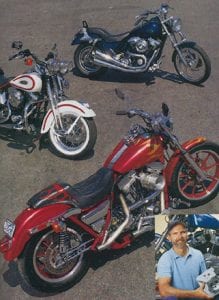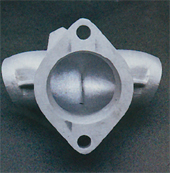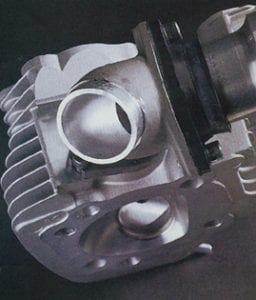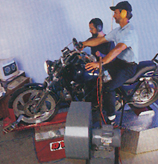You can build your Harley any way you want, but when you’re done, it’s still a Harley.
This statement has been made countless times by countless people allegedly wise in the ways of Milwaukee’s famous motorcycles. But Robert Johnson disagrees. In fact, he offers his own alternative conviction: “An engine can’t read what’s written on the valve covers.” That first remark says that the character of a Harley’s powerband doesn’t change, stock or modified: Off the bottom, torque is mighty, but it dwindles away as the revs build. Johnson’s philosophy, however, means that an engine doesn’t have to be stuck with the nature its manufacturer gave it.
Its nature can be changed
For proof, Johnson (owner-operator of Johnson Engine Technology, 10 Springbrook Rd., Westerly, RI 02891; 401/596-9507) presents his roadworthy 1200 Sportster, a bike that makes 94 foot-pounds of torque and 105 horsepower, as he says, “all sealed up”-meaning with mufflers. Its torque curve does not slope downward as the revs rise; it’s flat-the way a torque curve should be-to 6000 rpm. Johnson has a Big Twin, too, and its 80 inches make 114 horsepower. Both are completely streetable bikes that make big torque numbers everywhere. A stock Harley engine makes low-rpm torque for two reasons. First, it’s big. Second, it has the short-duration cams that favor cylinder-filling at low rpm. But once the revs start to build, those short cams don’t hold the valves open long enough to keep filling the cylinders, so the torque falls.
 Okay, slip in a longer-duration cam; this helps-some. It moves the torque peak up the scale, but it doesn’t change the long fall of torque after that still-early peak. Now bolt on a set of flowed heads. The torque peak moves up the rev scale again, but keeps its down-sloping trend thereafter.
Okay, slip in a longer-duration cam; this helps-some. It moves the torque peak up the scale, but it doesn’t change the long fall of torque after that still-early peak. Now bolt on a set of flowed heads. The torque peak moves up the rev scale again, but keeps its down-sloping trend thereafter.
Johnson wondered long and hard about this. After a stint working for an auto-racing R&D group, he bought an 883 Sportster. He thought about the power, the displacement and the rpm. None of it made sense. Having spent years serving on U.S. Navy nuclear subs, Johnson respects and understands engineering and its methods. He therefore made casts of the Sportster’s ports, sectioned the casts, and plotted port area as it varied from the carburetor to the valve. That didn’t make sense to him, either. There had to be some basis, some way of looking at this thing, that would reveal the plan behind the engine. But as far as Johnson could discover, there wasn’t.
 Then he began to apply what he knew from his auto-racing work. What should these ports look like, using the latest R&D, and based upon the Harley’s bore and stroke? The first conclusion he reached was that the 883’s ports were too big. The easiest way of fixing that was to increase the displacement to 1200cc.That move, along with down-sizing of the ports, produced substantially more power than did a stock 1200.
Then he began to apply what he knew from his auto-racing work. What should these ports look like, using the latest R&D, and based upon the Harley’s bore and stroke? The first conclusion he reached was that the 883’s ports were too big. The easiest way of fixing that was to increase the displacement to 1200cc.That move, along with down-sizing of the ports, produced substantially more power than did a stock 1200.
Smaller ports result in higher intake velocity, which, in turn, produces more vigorous charge turbulence in the combustion chamber.
Turbulence is the key
to fast combustion, and fast combustion, Johnson also knew, was a good way to avoid detonation-engine knock. With this higher port velocity, he was therefore able to raise compression to figures that would quickly overheat a stock Harley (10:1 plus). Even so, his small-port engine ran knock-free and without overheating. How fast is fast combustion? The usual range of ignition timing is 30-35 degrees BTDC, but Johnson’s 883/1200 made best power with the ignition set at a remarkable 23 degrees BTDC! This is impressive because such rapid combustion is usually associated only with highly developed race engines.
 Among the bikes Johnson has hot-rodded with his port-shrinking techniques are a Heritage Springer that’s nearly stock except for an Andrews EV3 cam, and two FXR’s – one mildly modified, and a 96-incher that belts out a whopping 137 horsepower.
Among the bikes Johnson has hot-rodded with his port-shrinking techniques are a Heritage Springer that’s nearly stock except for an Andrews EV3 cam, and two FXR’s – one mildly modified, and a 96-incher that belts out a whopping 137 horsepower.
The fact that Johnson’s 1200 was making more power than stock meant that somehow, more charge was getting into the cylinder through smaller ports. How could this work?
If you put a high-speed pressure sensor into an engine cylinder, and graph out the intake process, you first see the piston pull a deep vacuum. This occurs because the air in the intake port has inertia and takes time to get moving, to begin filling the cylinder. After that big pressure drop, you see the pressure trace slope back up as the intake air gets moving and tries to fill the cylinder.
Johnson’s work focuses on what happens around Bottom Dead Center, after the intake stroke. In a stock Harley, with its large ports and moderate piston speed, the intake airflow is moving at a leisurely pace. This means that as the piston reverses direction at BDC and starts back up the cylinder on its compression stroke, the inrushing intake air a mild breeze, really is easily stopped by the piston. That terminates the intake process, and is why the intake valve must close early. Staying open later would just allow the piston to push some of the fresh charge back through the intake valve and out of the cylinder – an occurrence often referred to as “reversion.”
Now let’s look at a modern racing engine at the same point. It could be a NASCAR engine, a Formula I engine or whatever; the principle is the same. Its intake ports are intentionally sized to produce a very high intake velocity by BDC, and they’ve been highly streamlined so that this high velocity doesn’t produce excessive air-friction loss. The piston starts back upward on the compression stroke, but the intake flow just keeps coming because its inertia makes it keep coming.
 How long can it do this?
How long can it do this?
How late should we close the intake valve? Well, we can get an idea from a handy little chart titled, “Pressure of air on coming to rest from various speeds.” Bernoulli’s Principle states that moving air has less pressure than still air; this is how carburetors suck fuel up through jets, into their high-speed Venturis.
In truth, pressure and velocity are interchangeable forms of energy.
Because of this, when a stream of fast-moving air is suddenly brought to rest, the energy of its velocity is converted to pressure.
Now think of our column of intake air, rushing into the cylinder at BDC, with the rising piston trying to bring it to rest. How high can the pressure in the cylinder rise before the flow stops? That depends on the intake velocity-on just how much energy there is in that moving stream of air. For example, the aforementioned chart says that stopping air which is moving at 230 feet per second (fps) will give us about 3-percent above atmospheric pressure. This velocity is a reasonable average for big, stock ports, and it’s clear that such slow-moving flow will be quickly stopped and reversed by the piston rising on compression. This means we have to close the intake valve right after BDC or else lose some charge to back-pumping-reversion, if you will. It also means we get very little cylinder-filling flow after BDC.
 Okay, but what if we double the intake velocity to 460 fps? The chart says stopping this flow gives us a 12-percent pressure gain over atmospheric-in other words, twice the flow, but four times the pressure. This quadrupled pressure means that intake flow can continue longer after BDC, allowing us to profitably close the intake valve later, trapping more fuel-air charge in the cylinder.
Okay, but what if we double the intake velocity to 460 fps? The chart says stopping this flow gives us a 12-percent pressure gain over atmospheric-in other words, twice the flow, but four times the pressure. This quadrupled pressure means that intake flow can continue longer after BDC, allowing us to profitably close the intake valve later, trapping more fuel-air charge in the cylinder.
How far can we push this process?
We can get a reasonable idea from a quick survey of purpose-built race engines of all kinds. At peak torque, the best engines can fill their cylinders to a pressure 20 percent or more above atmosphere. Running my thumbnail down the chart shows that 20 percent above atmosphere corresponds to a velocity of 580 fps. This is promising, and it is roughly what motivated Robert Johnson to apply the concept of shrink-porting to a Harley.
Understand, however, that intake velocity is not the only effect that can assist cylinder filling after BDC; a tuned intake length can also put sound waves to work here, achieving useful gains. But intake velocity is at least equally valuable.
 So, why isn’t everyone shrink-porting? Probably some builders are doing it, but traditional thinking stops many people from even considering such a move simply because it seems backwards. First, it’s easy to assume that a big engine needs big valves and big ports. But although its displacement is big, a Harley isn’t spinning at a NASCAR engine’s 8500 rpm. So, the numbers show that the ports are oversized to begin with.
So, why isn’t everyone shrink-porting? Probably some builders are doing it, but traditional thinking stops many people from even considering such a move simply because it seems backwards. First, it’s easy to assume that a big engine needs big valves and big ports. But although its displacement is big, a Harley isn’t spinning at a NASCAR engine’s 8500 rpm. So, the numbers show that the ports are oversized to begin with.
Second, when you put a Harley head on the flowbench and then get busy with the die-grinder, it’s pretty easy to get more flow, because the stock ports aren’t very streamlined. The man doing the porting feels good because he’s getting bigger numbers, and the customer is happy because he sees smooth, shiny ports. After all,
the whole idea of the flowbench is that more flow is supposed to translate into more power; but with a Harley, that relationship is weak.
Here’s why: The ports are already too big. Porting work therefore just lowers the intake velocity, making the engine even less able to flow air after BDC-especially at low and middle rpm. To get the value of a big-ported head, you have to rev the daylights out of it-to big, con-rod-stretching numbers like 7500. This is why so many people contend that “…when you’re done, it’s still a Harley.”
When asked if Harley’s Y manifold is a limiting factor, Johnson says that there’s nothing wrong with a Y (after all, it’s just a section of a V-Eight’s single-plane manifold), provided the port volume in the Y is kept small to match his small ports. “There’s also nothing wrong with two valves,” he contends, holding a cylinder head in his hands. Many people assume that because new engine designs use four valves, they must be better than two. But for a given valve area, you can get more flow through a single intake valve than you can through two. “The only reason for switching to four valves is to get more flow area for high rpm,” says Johnson. “The hemi combustion chamber shape is ideal for two valves.”
Okay, then why does the production Evo head use a big squish shelf, and so many of the ported heads have two of those shelves? “I don’t like squish,” says Johnson. “It gets in the way of flow. The combustion chamber shape is part of the intake port”.
Standard sources on porting
note that 40 percent of the flow loss across an intake port occurs on the exit side – after the flow has emerged from under the valve. The implication is that nothing can be done about this loss because it’s downstream of the port. Johnson says that’s not true. Instead of flanking the intake valve seat with squish areas, he blends it into the hemi head shape. The emerging flow “attaches” to the head contour, rather than forming a turbulent free-jet. This diffused, attached flow does a better job of smoothly converting velocity into pressure than does a free-jet, and the result is reduced port-flow resistance.
This technique apparently is used only by airflow specialists who don’t talk or write about their work, because Johnson is the first I have heard to articulate the concept. But I know it works because I’ve seen it on my own flowbench.
Squish is just a Band-Aid for some other problem,
claims Johnson. A man whose engine burns in a mere 23 degrees can say that and make it stick. He gets sufficient turbulence from his high-velocity intake process, so he doesn’t need squish to generate it-even above a 10:1 compression ratio. A stock engine, he observes, can get into a vicious cycle of heat, especially in slow traffic. Overheating causes the engine to knock when the throttle is opened, and knock causes more overheating. Harley fights knock with a low, 8.5:1 compression ratio, but there’s a better way:
Rapid Combustion
Fast burning reduces heat load two ways: First, the cylinder head is exposed to combustion for a shorter time; second, a fast burn means combustion occurs at a smaller volume, because the piston is closer to TDC. This smaller volume, divided into the engine’s stroke volume, gives greater expansion, which leads to lower exhaust-gas temperatures. That heats the exhaust valve and port less on its way out. The cooler the cylinder head runs, the less likely the chances of detonation. Johnson says his engine kits improve the stock 42 highway mpg up into the 55-60 range. This makes sense. Efficiency rises with compression ratio, especially when you start with a low number like 8.5:1.
 It’s interesting to run the numbers on Johnson’s 1200 Sportster, which makes a flat, 90-odd foot-pounds of torque from 3000 rpm upward on his Dynojet rear-wheel dyno. I like to translate these numbers into a familiar and universal figure of merit called BMEP, short for ‘Brake Mean Effective Pressure’. BMEP is combustion pressure, averaged over the whole stroke. It is that pressure which, if it acted constantly over the entire power stroke, would produce the same brake horsepower as does the real, rapidly varying combustion pressure in an engine that’s actually firing. A stock Harley engine gives a very modest peak BMEP that’s down around 125 psi; Dynojet printouts for
It’s interesting to run the numbers on Johnson’s 1200 Sportster, which makes a flat, 90-odd foot-pounds of torque from 3000 rpm upward on his Dynojet rear-wheel dyno. I like to translate these numbers into a familiar and universal figure of merit called BMEP, short for ‘Brake Mean Effective Pressure’. BMEP is combustion pressure, averaged over the whole stroke. It is that pressure which, if it acted constantly over the entire power stroke, would produce the same brake horsepower as does the real, rapidly varying combustion pressure in an engine that’s actually firing. A stock Harley engine gives a very modest peak BMEP that’s down around 125 psi; Dynojet printouts for
Johnson’s engines indicate peak BMEP close to 200 psi, a sensationally high number that would do credit to any modern race engine.
This is the best proof of his declaration that an engine can’t read what’s written on its valve covers. In other words, principles proven in supposedly high-tech applications can work just as well when applied to a Harley. Air is air. What Johnson builds for his customers is an integrated top-end system, complete from the base gasket up, including details such as pre-gapped rings. The hemi heads and high compression will only work with the high intake velocity of his small ports. High compression by itself, in a slower-burning stock engine, would cause knock and runaway overheating. In a low-intake-velocity engine, squishless hemi chambers would encourage detonation because such engines lack any other source of intake turbulence. The porting wouldn’t work as well without the hemi head to diffuse its flow. The concepts interlock. “All you have to do is slide them down over the studs,” says Johnson of his kits.
At present, his work involves time-consuming and very detailed in-port welding and hand-cutting, although he is switching soon to CNC. In-port welding isn’t easy. As Johnson puts it, “I can tell if there’s anything wrong in my life first thing in the morning, because if there is, I can’t do this.”
There are interesting ideas here, and more than a whiff of controversy. But Johnson is ready to take on all comers. In this business, patents give less protection than just staying ahead with a steady flow of ideas. Without question, Robert Johnson has plenty of those.
– Kevin Cameron


